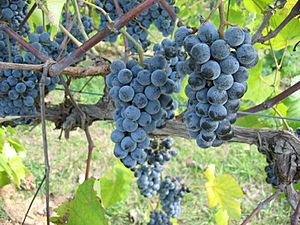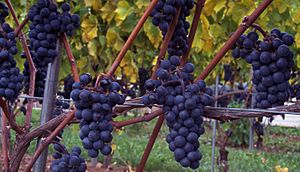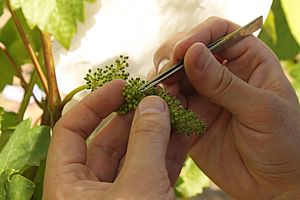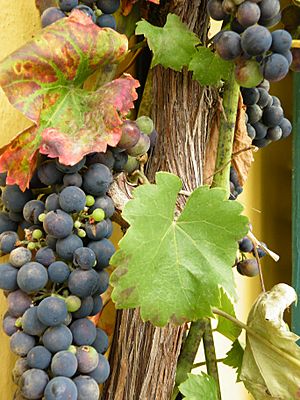Hybrid grape facts for kids
Hybrid grapes are special types of grape varieties. They are made by mixing two or more different kinds of Vitis grape species. Think of it like mixing two different kinds of dogs to get a new breed! This is different from most grapes, which are made by crossing two varieties from the same species, usually the European grapevine called Vitis vinifera.
Hybrid grapes are also known as "inter-specific crossings" or "Modern Varieties." They are great because they can often fight off plant diseases like powdery mildew and other fungus problems. They also resist tiny bugs called nematodes and a root louse called phylloxera. Because of these strengths, people in Europe are now looking at hybrid grapes again for growing. New hybrid grapes like Rondo and Regent are good examples. In North America, many grape growing programs, like those at Cornell and the University of Minnesota, focus only on creating new hybrid grapes. They have made thousands of new kinds!
Hybrid grapes have a mix of features from their parent plants, which can come from Europe, Asia, or North America. Some hybrids that come from the Vitis labrusca plant (like those used for Austrian Uhudler wine) can smell like "candied" sweets or "wild strawberries." Others that come from Vitis riparia might smell like herbs and taste like black currants.
Most red wines made from hybrid grapes don't have enough tannin. Tannin is what gives wine a dry, slightly bitter taste. Also, hybrid grapes often have more acidity than wines made from Vitis vinifera grapes. These differences made them less popular in Europe for a while.
History of Hybrid Grapes

In the early 1900s, people started special programs to create new grape types. This was to help with a big problem: the Phylloxera louse. This tiny bug destroyed many European vineyards starting in 1863. After trying many things, growers found the best way to fight the louse. They would graft European grapevines onto the roots of North American grapevines. These roots were strong against phylloxera.
However, hybrid grapes also became a solution for growing grapes in places with shorter growing seasons, cooler weather, and more humidity. These areas include the northeast and Pacific Northwest of North America. Since the 1950s, grapes like De Chaunac, Baco noir, Marechal Foch, and Vidal have been very important for winemaking in places like Ontario, New York, and Pennsylvania.
Even though Vitis vinifera grapes are now more common in some of these areas, hybrid grapes still have loyal fans. Sometimes, hybrid grapes are used to make special products. For example, ice wine made from Vidal blanc or Vignoles in Ontario and New York is very popular.
Hybrid grapes are becoming more common even in places where Vitis vinifera grapes are traditionally grown. This is because hybrids are often easier to grow. They can ripen earlier, which means birds are less likely to eat them. It also means they are harvested before the fall rains start. Plus, they are usually much more resistant to diseases. This means farmers don't need to spray as much, which saves fuel and reduces chemicals. Because of these benefits, hybrid grapes are seen as a "Green" or eco-friendly choice for growing grapes.
Different Grapevine Species

Here are some of the most well-known types of grape species used for growing grapes:
- Vitis vinifera: This is often called the European or wine grape. It comes from the Eurasian area. Many famous table grapes and wine grapes belong to this species. Some examples are Riesling, Chardonnay, Cabernet Sauvignon, Pinot noir, Merlot, and Gamay.
- Vitis aestivalis: This grape is native to eastern North America.
- Vitis rupestris: This species is also native to North America.
- Vitis riparia: Sometimes called the "river bank grape," this species is native to northeastern North America.
- Vitis amurensis: This is an Asian grape species that comes from Siberia and China.
- Vitis rotundifolia: These are the muscadines, which are native to the southern half of the United States.
- Vitis labrusca: This grape is native to northeastern North America. Grapes like Concord and Niagara are hybrids that have a lot of Vitis labrusca in them.
Sometimes, different grape species can cross-pollinate naturally in the wild. This can create new hybrid vines. Because there are many different American Vitis species, you can find these natural hybrid vines in America. However, most of the well-known hybrid vines we have today were created by people. The first named hybrid in America was the Alexander grape. It was found around 1740 near a vineyard planted for William Penn.




